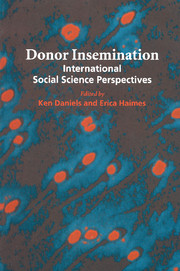Book contents
- Frontmatter
- Contents
- List of figures
- List of tables
- Notes on contributors
- Acknowledgements
- List of abbreviations
- 1 International social science perspectives on donor insemination: an introduction
- 2 The users of donor insemination
- 3 Families created through donor insemination
- 4 The making of ‘the DI child’: changing representations of people conceived through donor insemination
- 5 The semen providers
- 6 The medical management of donor insemination
- 7 Regulation of donor insemination
- 8 Donor insemination and ‘public opinion’
- 9 Concluding comments
- Index
4 - The making of ‘the DI child’: changing representations of people conceived through donor insemination
Published online by Cambridge University Press: 04 August 2010
- Frontmatter
- Contents
- List of figures
- List of tables
- Notes on contributors
- Acknowledgements
- List of abbreviations
- 1 International social science perspectives on donor insemination: an introduction
- 2 The users of donor insemination
- 3 Families created through donor insemination
- 4 The making of ‘the DI child’: changing representations of people conceived through donor insemination
- 5 The semen providers
- 6 The medical management of donor insemination
- 7 Regulation of donor insemination
- 8 Donor insemination and ‘public opinion’
- 9 Concluding comments
- Index
Summary
Introduction
The purpose of donor insemination is starkly simple: to create a child. However, since surprisingly little is known about the babies conceived in this way, it is not possible to present a view of DI from the child's perspective, since we do not really know what that is. What we do know comes mostly from what the other parties involved in DI (e.g. the clinicians, the recipients, the policymakers, the social analysts) consider to be the child's needs and interests.
In this chapter I shall examine how others have represented the ‘DI child’, in both senses of ‘representation’: how others have claimed to speak on behalf of the ‘child’ and how, in making such claims, they have also presented a certain image of DI offspring and have shaped how they might be perceived. The ‘DI child’ is as much, if not more, a product of these social processes as s/he is of the physiological. I shall use extensive quotations from various sources as a way of displaying the data from which my interpretations have been drawn, to show how such representations have varied over time.
Elsewhere I have written about the practical, clinical and policy issues around the ‘DI child’ (e.g. Haimes 1990, 1992, 1993) but here I want to provide an analysis at another level, that focuses not so much on the issues themselves but on what those issues reveal about the way in which the person conceived by DI is seen by others.
- Type
- Chapter
- Information
- Donor InseminationInternational Social Science Perspectives, pp. 53 - 75Publisher: Cambridge University PressPrint publication year: 1998
- 7
- Cited by



